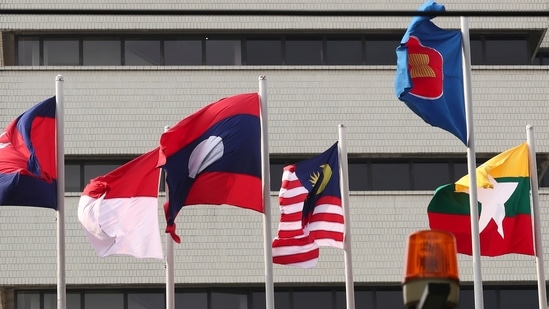ASEAN’s Lilliputian progress in Myanmar
The piece has been authored by Shrabana Barua, ICSSR Doctoral Candidate, School of International Studies, Jawaharlal Nehru University
On September 6, news about a four-month ceasefire by all parties of the current conflict in Myanmar, proposed by the Association of South East Asian Nations (ASEAN) Special Envoy on Myanmar, was doing the rounds in the international media. The very next day, The Irrawady, reported ‘Myanmar Junta Denies Accepting ASEAN Ceasefire Proposal’. This, yet again, comes as a reminder to the world of the complications of diplomatic talks with the country’s military regime that usurped power through a coup on February 1, 2021.

ASEAN Lead
By June, five months after the tatmadaw (military) ousted the democratically-elected leaders led by Aung San Suu Kyi, the international community seemed to have fewer substantial options. Already, nearly 600 people had been killed, 6000 arrested, 5000 detained and about 100 had disappeared. The United States (US) and European Union (EU) imposed sanctions on individuals and groups involved with the coup, including Senior General Min Aung Hllaing, now the self-proclaimed prime minister of Myanmar. It looked like the harshest admonishment at the time, compared to superficial word sake condemnation by many states. The Special Envoy of UN Secretary General on Myanmar, Christine Schraner Burgener, was disallowed to visit Myanmar on the grounds that “it was not the right time”. Not to mention the lack of unanimity within the Security Council to take meaningful action to reverse the political, humanitarian and Covid-19 crises that Myanmar was reeling under.
It was at the same time that the representatives of the ASEAN landed in Naypidaw. Secretary General Lim Jock Hoi and Brunei's second minister for foreign affairs, Erywan Pehin Yusof, spoke to the military leaders in Myanmar on June 4. Many doubts and concerns were raised about ASEAN’s diplomatic dexterity. But, it seemed that ASEAN was the only viable way to deal with the ensuing problems in Myanmar.
Mediation Process
Along with Laos, Myanmar obtained full membership of ASEAN in 1997, rather swiftly, despite protests from Thailand and Philippines at the time. When Myanmar was gripped by political upheaval this year, it was certain that ASEAN had to step in, notwithstanding calls for its expulsion from democracy groups and human rights activists. How it would progress was under discussion.
On April 24, a ASEAN Special Summit on Myanmar was held in Jakarta. Two main issues were immediately visible. First, despite the differing opinions within the inherently diverse regional grouping of the ASEAN, it’s invitation to Min Aung Hllaing to participate in the discussion was seen by many as legitimising the military regime, against whom opposition had strengthened both within and outside Myanmar. The National Unity Government (NUG) that formed a shadow government demanded to be invited instead. This claim found support from many quarters in the region. The West too protested ASEAN’s decision. The mediation process looked tainted.
Second, the Five-Point Consensus that emerged as the core of the ASEAN led negotiations was sidelined by the junta. Among other things, it proposed the following -- immediate secession of violence and observance of restraint by all parties; appointment of a Special Envoy of the ASEAN Chair who would mediate a dialogue process as well as visit Myanmar to meet all stakeholders; provision of humanitarian assistance through the ASEAN Coordinating Centre for Humanitarian Assistance. This was reiterated during the ASEAN envoy’s visit in June. However, attempts at theimplementation of these proposals have not been smooth.
The plus and the minus
ASEAN’s forays into a politically turbulent, economically weak, socially vulnerable and Covid-stricken Myanmar was bound to be a slow and slippery process. On the positive side, the fact that the junta leaders have not rejected the Five Point Consensus, allowed ASEAN envoys to visit the capital in June and are in talks currently with the ASEAN Special Envoy on Myanmar on various issues, including a visit with full access to all parties concerned, is a sign of hope. On the other hand, the hurdles are multi-pronged. The Myanmar crisis has uncovered many fault lines within ASEAN itself. The painful delay in electing the ASEAN Special Envoy until the first week of August is a clear example. Given that Covid-19 and the coup have created a recipe of another humanitarian disaster in Myanmar, ASEAN’s slow actions can easily translate into closure of opportunities and further loss of life. Additionally, the ephemeral decisions of the junta and its support from external powers need to be closely monitored. The fact that Sun Guoxiang, China’s Special Envoy for Asian Affairs, managed to pay an unannounced yet successful visit to the capital in early September is indicative of red flags on the way ahead. But as the saying goes, “some progress is still progress”. For now, as ASEAN is withstanding the international burden of bringing out peace and stability through negotiations in Myanmar, it must be externally supported.
The piece has been authored by Shrabana Barua, ICSSR Doctoral Candidate, School of International Studies, Jawaharlal Nehru University



